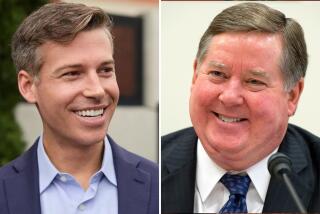Rep. Calvert’s Land of Plenty
- Share via
WASHINGTON — Rep. Ken Calvert (R-Corona) is an experienced investor in Riverside County’s booming real estate market, so he’s used to seeing prices change quickly. Last year, he and a partner paid $550,000 for a dusty four-acre parcel just south of March Air Reserve Base. Less than a year later, without even cutting the weeds or carting off old septic tank parts that littered the ground, they sold the land for almost $1 million.
Even for a speculator like Calvert, it was an unusually good deal.
For the record:
12:00 a.m. May 18, 2006 For The Record
Los Angeles Times Thursday May 18, 2006 Home Edition Main News Part A Page 2 National Desk 2 inches; 74 words Type of Material: Correction
Rep. Calvert and freeway interchange: An article in Monday’s Section A about real estate deals involving Rep. Ken Calvert (R-Corona) said the lawmaker had secured federal funds to build an interchange between Interstate 15 and Cajalco Road in Riverside County. The funds are for a major overhaul and expansion of an existing interchange. The accompanying graphic referred to the project as a proposed interchange when it should have identified it as the proposed improvement.
During the time he owned the land, Calvert used the legislative process known as earmarking to secure $8 million for a planned freeway interchange 16 miles from the property, and an additional $1.5 million to support commercial development of the area around the airfield.
A map of Calvert’s recent real estate holdings and those of his partner shows many of them near the transportation projects he has supported with federal appropriations. And improvements to the transportation infrastructure have contributed to the area’s explosive growth, according to development experts.
Calvert said he had used earmarking solely to benefit his district. Those appropriations, he said, have had nothing to do with his investments or financial gains.
“Because of the political atmosphere in Washington, D.C., people are trying to manufacture controversy, even where there isn’t any,” Calvert said. Noting that property values have climbed throughout the Inland Empire, he added: “They haven’t passed a law against investing yet.
“All my life in public service, I’ve never done anything to enrich myself, using the position I hold,” he said.
The projects he helped fund, Calvert said, were requested by local officials. Those officials agree. Referring to the effort to commercialize the area around March airfield, Riverside County Supervisor Bob Buster said Calvert had been “very active for a number of years, and in a variety of ways.”
What sets Calvert’s actions apart from the traditional efforts of lawmakers to bring federal dollars home to their districts is that some of the spending has gone for improvements near his private real estate ventures, and he has used earmarking to secure the tax dollars.
Earmarking is a practice in which some members of Congress -- primarily those in leadership positions, those on appropriations and transportation committees, and other insiders -- are allowed to insert into federal spending bills provisions that allot tax dollars for particular projects without going through the normal legislative and budgetary reviews.
Not every lawmaker is equal when it comes to being able to earmark appropriations. What counts is where members stand in the power structure, and how much favor they cultivate with more influential colleagues. Some lawmakers are allowed to insert scores of earmarks into spending bills each year. Others get few, if any.
And the process traditionally occurs behind closed doors, without public notice or hearings. Spokespeople for the House Appropriations and Transportation committees, for instance, refuse to provide information on lawmakers’ earmark requests or their justifications for projects. As a result, an individual lawmaker quietly can obtain funding to help constituents, interest groups, lobbyists or even themselves.
The number of earmarks has sharply increased in recent years. Earmarks such as the $223-million “bridge to nowhere” -- connecting the town of Ketchikan, Alaska, to an island with an airport and about 50 inhabitants -- that was included in last year’s highway bill have generated demands for reform.
To shed more light on the process, the nonpartisan watchdog group Taxpayers for Common Sense has worked to identify and analyze earmarks in recent spending bills. During the 2005-06 congressional session, Calvert put 69 earmarks into spending bills, the group reported; Calvert said he was the lead advocate for 53.
Such special funding is often decried as “pork” by spending hawks and good-government groups, but many members of Congress counter that the practice serves their constituents.
In extreme cases, manipulation of federal spending has been linked to corruption. Former Rep. Randy “Duke” Cunningham (R-Rancho Santa Fe) admitted taking bribes in exchange for such legislative favors. And Rep. Alan B. Mollohan of West Virginia recently stepped down as the top Democrat on the House Ethics Committee amid allegations that he steered federal money to nonprofit groups in his district -- organizations run by business associates who helped make him wealthy.
Earmarks also figured into the political corruption scandal centered on former lobbyist Jack Abramoff.
In addition to earmarking funds for infrastructure, Calvert has directed money toward such things as education, university research and agriculture.
He also has secured funds for a number of projects pushed by campaign contributors, including employees of the Washington lobbying firm of Copeland Lowery & Jacquez, his top political donor in the last election cycle.
But the most serious questions, ethics specialists say, involve Calvert’s participation in real estate ventures in which his earmarks for highway and other improvements may have contributed to rising land values and created at least the appearance that he personally benefited.
Stanley Brand, a former general counsel to the House of Representatives who frequently represents lawmakers in ethics cases, said members should avoid earmarks that might be seen as self-enriching.
“I’d advise them to either sell their property interests in the immediate area or recuse themselves from any related earmarks,” he said.
Another ethics expert, Brett Kappel, said that any member of Congress who dealt in real estate should be especially careful in earmarking funds for projects that could be seen as providing a benefit to his holdings.
“It could be perfectly legitimate, but it raises an appearance issue when you have a member who is a property owner, and he or she earmarks funds to benefit development in an area in which the member has an ownership interest,” said Kappel, who advises private-sector clients on ethics rules for the law firm of Vorys, Sater, Seymour & Pease.
Kappel said that it would be helpful to a lawmaker if the project in question had been requested by a local government agency -- which is the case with the interchange project and the improvements around March airfield -- and if the member disclosed the earmark and the property holding.
Calvert issued a news release announcing the interchange, but his financial disclosure for 2005, the year of the property purchase near March airfield, at 18966 Seaton Ave., has not yet been filed.
Some lawmakers who, like Calvert, were in the real estate business before they got to Congress have cut their ties and refrain from buying any property in their districts for other than personal use.
“What gets you in as much trouble around here as a conflict is the appearance of a conflict,” said Rep. Elton Gallegly (R-Simi Valley), who has adopted that approach.
Calvert, 52, who was first elected to Congress in 1992 and is seen as a rising figure among House Republicans, is better positioned to get earmarks than most; 69 earmarks this session would be considered large for a lawmaker who sits on neither the Appropriations nor Transportation committees. He is expected to get a seat on the appropriations panel soon, replacing the retiring Rep. Tom DeLay (R-Texas).
Calvert also is a member of the House Republican Steering Committee, which selects committee chairs, and is vice chairman of the California House GOP delegation. He has a political action committee that has begun to funnel campaign contributions to House colleagues, a well-established road to greater power and influence.
Calvert’s most recent financial disclosure statement, filed last May, showed that he owned eight parcels of land, most in Riverside County.
In 2004, according to the disclosure statement, he owned stock valued at between $250,001 and $500,000 in Calvert Real Properties Inc. and received dividends of between $50,001 and $100,000. The exact value of his holdings is unclear because congressional disclosure forms require members to indicate where their assets and liabilities fall within specified ranges but do not require disclosure of specific amounts.
In 2005, Riverside County property records show, Calvert and his partner, Woodrow Harpole Jr., closed on the purchase of the 4.3 acres of land near March airfield and the east end of Cajalco Road for $550,000. Calvert’s real estate firm received brokerage fees from the seller, Rod Smith of Greeley, Colo., for representing both buyer and seller in the deal.
On Aug. 10, 2005, President Bush signed the highway bill that provided $8 million toward building an interchange connecting Cajalco Road with Interstate 15. A Calvert earmark in the bill provided $1.5 million to improve a section of the decommissioned Air Force base for commercial use. Several months after the bill was signed, Calvert and his partner sold the property for $985,000, a 79% increase.
The congressman and his partner said the increase in value was unrelated to the federal funding for the interchange or the air base.
Still, in a mid-2005 news statement announcing his accomplishments in the transportation bill, Calvert said the interchange would “provide efficient and direct connectivity for the March Air Reserve Base.” And local property sales personnel say they refer to coming transportation improvements when marketing their real estate.
Reform advocates, such as Keith Ashdown of Taxpayers for Common Sense, say more transparency in the process is needed -- particularly in the case of transportation earmarks that have become a specialty for Calvert and other lawmakers.
“These highway interchange projects are performance-enhancing drugs when it comes to property values,” said Ashdown, who advocates full disclosure of earmarks and a rule that would require any lawmaker securing one to disclose property interests at the time of the earmark.
Federal agencies, including the Department of Transportation, repeatedly have asked to review earmarks with House members. And many have done just that, but Calvert is not among them, according to a Transportation Department official.
Calvert said Friday that members know their districts’ needs better than officials in the executive branch do.
Early last summer, another deal developed when Harpole -- vice president of Calvert’s real estate firm -- bought property with a group of investors at 20330 Temescal Canyon Road, a few blocks from the site of the proposed interchange at Cajalco and I-15. The purchase price was $975,000. Within six months, they sold the parcel for $1.45 million.
Calvert’s firm took a commission on the sale.
Calvert owns other properties that might be affected by his earmarks. For example, he and Harpole own properties close to a bus depot for which the congressman sought funding in Corona. He and Harpole sold one of those parcels in 2005; Calvert said the earmark had no effect on the value of the property.
Describing how he and Calvert work together, Harpole said, “We never talk about politics, and I don’t talk about things in real estate except to say, ‘Yes, we are paying our bills and we have money in our account.’
“And of course I have to consult with him if we are looking at investing his money” in a real estate deal, he added. Recently, Harpole said, “I told him about one and he said, ‘No, I don’t think so.’ ”
*
Hamburger and Simon reported from Washington and Pugmire from Riverside County. Times staff writers Walter F. Roche Jr. and Willem Marx in Washington contributed to this report.
More to Read
Get the L.A. Times Politics newsletter
Deeply reported insights into legislation, politics and policy from Sacramento, Washington and beyond. In your inbox three times per week.
You may occasionally receive promotional content from the Los Angeles Times.











